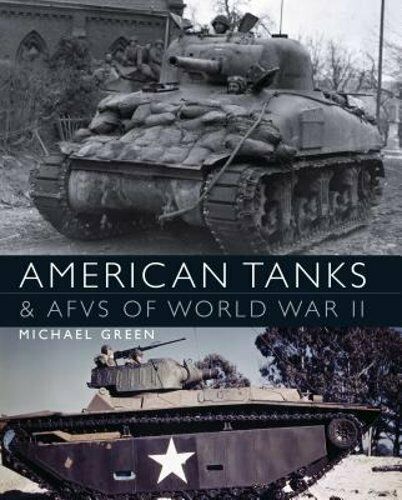
American Tanks & AFVs of World War II
Michael Green
376 pages including notes & index
published in 2014
It’s a fact of life that interest in World War II armour tends to focus on Nazi Germany, with Soviet vehicles perhaps a distant second. Understandable, considering how many interesting and downright strange types made it into production or had at least a prototype created. It’s always tempting to think about what if those potential wunderwaffen had made it into service, whereas the realities of western allied armour are always much more mundane. At least the French and to a lesser extend, the British, had some cool but impractical dead ends available in the early war, but American armour was just relentlessly pragmatic. the answer to any problem encountered seemed to be let’s build more Shermans, rather than creating some new exotic prototype.
American Tanks & AFVs of World War II does nothing to disabuse you of those preconceptions. Yes, there are some what ifs to be found, but in case after case what Michael Green documents here is the ruthless pragmaticism of the US army during world War II. It’s not just that the whole design and procurement process was much more centralised and efficient than that of Nazi Germany — but it certainly helped that there was no Hitler type mucking about on the US side. It’s also that the first instinct was always to look for solutions through modifying existing vehicles, rather than creating new ones. A determination not to let the perfect be the enemy of the good or even good enough. If it worked, why replace it just because there was a better option? That’s the attitude that comes across reading this book.
After a short introduction, American Tanks & AFVs of World War II starts with the development of medium tanks between the wars, culminating in the M3, the first major US tank of World War II, which saw action in North Africa and Italy, as well as the Pacific. This is followed by a long chapter on the development of the ultimate American medium tank, the M4 or Sherman. The Sherman as a tank had always been a bit confusing to me, because its long production and gradual evolution meant there were a confusing number of subvariants and it isn’t always easy to distinguish them. Therefore I appreciate Michael Green’s efforts here to make sense of them all. With the focus on World War II it’s not an entirely complete story of course, as there were numerous post-war variants as well. Not to mention British variants like the infamous Firefly.
The chapters on light and heavy tanks are together only slightly longer than the M4 chapter, which shows its importance. The heavy tank was never that much of a priority to the US army in the war; there never was an equivalent of the Tiger. The 75 or 76 mm armed Sherman was deemed good enough. When there was a demand for a more heavier armoured tank therefore, the Sherman was up-armoured rather than a new tank created. The only tank taken into service that could be classified as heavy would be the M26 Pershing, which only arrived very late in the war. On the light tank front, things were somewhat different. The M3 and M5 series were excellent scout vehicles much used by both the US and the British/Commonwealth, while the M24 was the ultimate WWII light tank, armed with a similar 75mm gun to the Sherman. Again it’s telling that the 37mm armed M3/M5s were kept in service for so long despite their main armament being obsolete almost from their introduction. Their role wasn’t to fight other tanks and the US was never tempted to upgun them just because they could.
Tank destroyers were an important part of US army doctrine, as they were intended to fight enemy tanks rather than leaving it to the tanks themselves. This used to be the tasks of towed anti-tank guns before the war, but the German blitzkrieg put paid to the notion that towed guns could suffice. The first generation of tank destroyers mated existing, often obsolete guns with wheeled vehicles or half tracks. There was e.g. the M3 half track with a World War I vintage 75mm gun that was used in North Africa and Sicily. With the limitations of this sort of design becoming obvious, the next step was to create tank destroyers from existing medium tanks. The M10, M18 and M36 all used the M4 chassis with new turrents and different guns: a 3 inch, 75mm and 90mm respectively as demands for more fire power increased.
The remaining chapters detail the more niche armoured vehicles used in World War II: armoured cars and half tracks, self propelled artillery and tracked landing vehicles. The ruthless pragmatism of the US army really shows through well in these first two categories, with only a very limited number of different armoured cars and half tracks ever taken into series production. The first especially, with only a few types of light armoured cars taken into service and no heavy ones, unlike other armies. With self propelled artillery, there was the same sort of trajectory as with tank destroyers: first using wheeled vehicles before moving on to using the M3 and M4 tank chassis. Tracked landing vehicles were of course mostly used in the Pacific, but also by some of the river crossings in North West Europe late in the war. Again, any improvement here was evolutionary rather than revolutionary, with heavier armament added as needed.
If you want a one shot overview of American tank and armoured vehicle development during World War II, this is an excellent introduction. Plenty of excellent photos and illustrations too help tell the story. Recommended.
No Comments